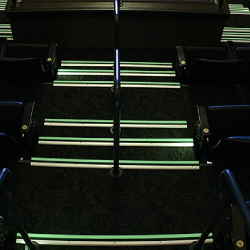









As building codes evolve, many property owners and managers periodically need to upgrade their stair tactile for continued safety and accessibility compliance. This comprehensive 101 guide will share the best practices for safely removing outdated tactile solutions and replacing them with code-compliant options from Tactile Solutions Canada.
Regular replacement ensures:
Safety: Old tiles can lose slip resistance or visibility over time, increasing fall risks.
Compliance: Evolving codes like AODA necessitate upgrades to current standards for legal protection.
Longevity: New tactile last decades versus patch repairs on failing installations.
Sustainability: Proactive replacement minimizes costly retrofits and hinders accessibility later.
Aesthetics: Modern tactiles match contemporary interior/exterior design aesthetics.
Projecting accessibility needs, facilities budget tactile life-cycles alongside other significant components. Replacing aged tiles guarantees continued safe mobility for all.
It is essential to prioritize the safety of workers and building occupants during replacement projects:
Restrict Stair Access: Barricade stairs undergoing work must avoid falls into the site.
Personal Protective Equipment: Hard hats, steel-toed boots, gloves, and eye protection minimize risks.
Fall Protection Equipment: Harnesses tether workers to stable anchors for elevated tasks.
Slip Guards: Apply slip-resistant tape to stair edges lacking code-compliant nosing.
Signage: Warn about temporary slip/trip hazards and guide occupants to alternate routes.
Dust Control: Contains fine debris from cutting/grinding to prevent inhalation hazards.
Thorough planning and precautions enable smooth, secure upgrades benefitting future stair users for decades.
Proper removal prevents damage to substrates:
Cast-in Stair Tactiles: Use an angle grinder and masonry blade to cut inserts flush along the perimeter.
Surface-Bonded Tactiles: Score substrate adhesive lines with a circular saw, heat gun, or solvents before lifting inserts intact.
Stair Nosings: Drill out or cut bonds between old nosings and treads/risers for gentle removal.
Clean Residue: Completely remove glue and dust with solvents or abrasives to ensure strong bonds for new tactiles.
Inspect Substrate: Check for cracks and delamination requiring patching before relacing tactile.
Neat, tidy removal readies surface for code-compliant replacements, adhering securely for long service life.
Choosing replacements involves considering the following:
Application: Stair tactile, stair nosing, or both
Location: Indoor, outdoor, or both
Material: Metal, polymer, porcelain for durability
Installation Method: Cast-in or surface-applied
Standards: AODA, NBC, CSA B651, IFC for accessibility, sustainability
Warranties: Longevity assurances
Tactile Solution Canada offers a wide selection of indoor/outdoor, cast/surface tactile, and stair nosings in numerous durable materials to suit all project needs.
Consult product information and installation guides, ensuring upgrades meet the latest codes and pass rigorous testing qualifications. Proper specification leads to smooth installations.
Refer to manufacturer specifications and these general guidelines:
Prepare formwork and pour concrete substrate.
Set impregnated wood stakes along pouring lines at proper depths.
Place tactile into wet concrete, tapping around the perimeter until flush.
Allow curing, then strip forms and inspect for gaps and voids requiring patching.
Clean and dry the substrate thoroughly.
Apply adhesive in a zigzag pattern, leaving 1/8” gaps at the edges.
Firmly press tactile into place aligned along stakes or strings.
Drill and set anchors for stability on sloped substrates prone to shifting.
Inspect bonding after full curing and fill gaps less than 1/32”.
Proper installation results in securely adhered tactile meeting code and ensures long-lasting slip resistance, guidance, and detectability.
After allowing full curing, conduct thorough inspections:
Bonding: Check the entire tactile perimeter for secure adhesion
Level: Ensure flush mounting without height variations
Gaps: Fill any openings less than 1/32” to prevent debris traps
Alignment: Maintain uniform staggered joint spacing along the stair
Visibility: Inspect retro-reflectivity and luminance of stair nosings
Slip Resistance: Test non-slip properties are retained
Compliance: Verify specifications meet referenced accessibility standards
Document inspections. Address any deviations immediately under warranty. Periodic inspections keep tactile functioning optimally throughout their service life. With diligent planning, safety procedures, and proper methods outlined here, upgrading aging stair tactile is simple yet impactful for continued code compliance and accessibility long into the future.
A. Project timelines vary by size, but for average residential staircases, expect 3-5 hours for removal and installation if conducted after hours to minimize disturbances. Larger commercial projects may take days to weeks.
A. If concrete is deteriorated, primer and bonding agents may restore soundness. Otherwise, replacement may be necessary. Consult with manufacturers about compatible repair options.
A: Most tactile contain recyclable metals and plastics. Consult local regulations, but construction waste facilities or metal recyclers usually accept them. Avoid landfilling wherever possible.
A4: Ideally, every 10-15 years, or sooner if tactile show signs of wear, loss of slip-resistance, or UV damage compromising visibility. Stair inspections catch failures early for timely, safety-focused upgrades.
As the trusted accessibility tactile provider in Canada, Tactile Solution Canada can ensure your stair replacement project meets all code requirements through expertise, quality products like Ecoglo stair nosings, and comprehensive pre/post-job guidance. Convenient scheduling, warranty assurances, and expertise deliver seamless, compliant projects. Consult Tactile Solution Canada today for all your stair accessibility needs!
